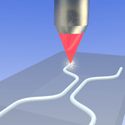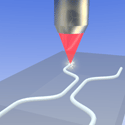Towards a handheld optical table
A typical quantum optics experiment takes place in a laboratory filled with numerous freestanding components mounted to an optical table. All of these optical elements require careful alignment and stabilization—a limitation that could be overcome by instead embedding the optical components on a single rigid structure, such as a chip.
Writing in Physical Review Letters, Linda Sansoni and colleagues at Sapienza Universitá di Roma and collaborators at several institutes in Italy describe a beam splitter they fabricated in a glass structure for use in an integrated photonic circuit on a chip. A beam splitter, which separates one beam into two, is often an essential component for optical experiments. To make the beam splitter, they focused femtosecond infrared laser pulses on borosilicate glass and etched pathways for the input light. By measuring input and output light for nonentangled and entangled photon states, the group showed that their device preserves the polarization of the input light.
The polarization-preserving feature of Sansoni et al.’s device makes it potentially useful for tasks like cryptography and linear optics quantum computing that are based on the information stored in the polarization of light. – Sonja Grondalski





